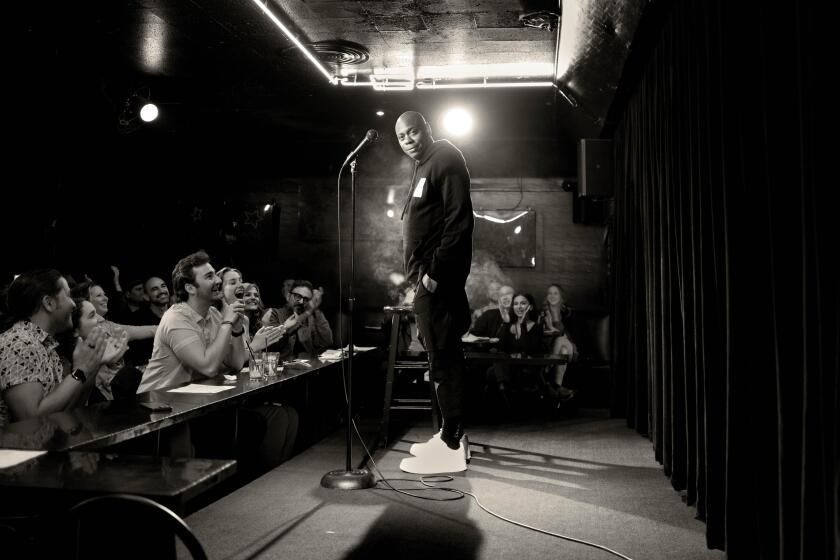Stand-ups explain why it pays to sharpen crowd-work skills. ‘It keeps me on my toes’

- Share via
“This is going terribly,” Matt Rife announces at his ProbleMATTic show at Los Angeles’ Dolby Theater. “This” is a repartee with a young female fan, who initially interjected to reveal that the two share the comedian’s home state of Ohio in common. After mining for more information (she’s from Cincinnati, and that’s about it), Rife cuts the interaction short and addresses the crowd directly. “It isn’t always like what you see online,” he reveals.
Although, what we’ve seen online is the reason many of us are here. Quick-hit content of Rife’s crowd work has gone viral so frequently, the stand-up is now synonymous with off-the-cuff witticisms. Now, Rife is headed for household-name status — making his Netflix debut last November with a special that incensed critics. In the days before this L.A. show, Rife responded with an “apology” that advertised helmets intended for people with special needs. His next big LA stop will be at the Hollywood Bowl for the Netflix is a Joke festival on May 8. Tonight, a middle-aged man sitting in the second row has brought one for him. “I think people do come with a certain expectation,” Rife says of the interruptions that occur at his shows. “They see something online and aspire for it to be them in that certain situation, which I feel bad for because it might not happen.”
Like many other digital-age comedians, Rife started sharing his crowd work to win the attention of time-deficient audiences. While visibility in the comedic space once demanded near constant touring and a formidable manager, now social media has facilitated self-promotion via podcasting (hosting your own or tirelessly guesting on others) or DIY sketches. While L.A.-based comic Trevor Wallace has done all the above, he emphasizes nothing converts an online fan to real-life show attendee quite like stand-up.
“I do think any content that’s stand-up-related is better [for sales],” says Wallace. “[I get] a lot of like, ‘I saw a stand-up clip and didn’t know you did that … now I’m here.’”
“I actually thought that crowd work was this magical thing that only a couple comics did and I never thought I was wild enough to do it,” explains New York comedian and host Hannah Berner.

For much of Berner’s early comedic career, she refused to stray from her written set — assuming anything less than perfection might reinforce the worn-out stereotype that women aren’t funny. When a club manager advised her to “bomb more,” Berner finally gave herself permission to let go. Specifically, she decided to embrace audience interaction.
“It’s high risk and high reward, because once you gain the audience’s trust it’s the best feeling in the world and you ride that momentum,” she says. “I also sometimes am just nosy and want to know how long two people are dating based on how close they are sitting together.”
Now, crowd work seems to make up more than 50% of Berner’s online content. Mostly, it has become a necessary — and fruitful — workaround for burning written material.
“I would argue that early on, you can post some good bits to get traction and for people to hear your voice,” she says of sharing her set, “But when you are putting together a special, you don’t want your jokes already all over the Internet.”
This is an overdue clarification, says Rife, alleging fans who are less familiar with stand-up comedy can’t recognize crowd work’s promotional function. “They think that because you only post crowd work that that’s all you can do, and it’s like, ‘No, I don’t want you to pay to come see me in person to see the exact same jokes you just saw for free.’”
Throughout Rife’s show, it became increasingly clear just how emboldened an audience can be from their online experience. The interruptions were frequent and, when addressed by Rife, devolved into a generally inconsequential interaction.
This, Rife says, is crowd work’s key drawback. Very rarely does he receive an A1 response from an audience member, so much so that the comedian is known to say “Not funny, moving on.” (Of course, those snippets don’t make it to social media.) “You don’t see the lowlights, you don’t see [me talking] to somebody who gives me absolutely nothing,” Rife says, adding it’s often the person he calls upon at random who gives the best responses. “It’s never the person who yells out — it’s always like the quiet ones that are the least assuming.”

With the exception of belligerence, Wallace considers even the most benign audience offering an opportunity. In one of his most-watched crowd work clips, he asks the audience where they lost their virginity — to which one woman replies, “a glacier.” It was the kind of outlandish response he could only dream of, yet, he’s always prepared to play out the other side. “Let’s say some guy in the front row goes, ‘Mine happened on a futon,’ then I would stop and be like, ‘That’s your crazy story? What’s next, a hammock?’”
“It feels like there’s a basketball game,” says Wallace, adding he took improvisational classes to not only trust his gut on stage, and better handle heckling: “It feels like when I’m up there and somebody says something dumb, ‘I’m like, alright, let’s have fun.’” While Wallace’s Amazon special “Pterodactyl” premiered just one day before Matt Rife’s “Natural Selection” on Netflix, he eschews Rife’s more experiential stand-up for character comedy. A recent review of “Pterodactyl” warns viewers not to compare Wallace’s stand-up to that of other Internet comedians, with the caveat: “unless you consider his crowd work.”
“I think ultimately the goal of crowd work is to show off comedic timing, but also show off like, oh, my crowds are just fun — this looks like a fun event,” Wallace says.
Surprisingly, crowd work is not without stigma. Many, more traditional stand-ups expect a full hour of written material rather than riffing off crowd interaction. Rife is repeatedly accused of being a strictly crowd-work comedian — a misconception he even spoofed in the teaser for his Netflix special— even though he engages with audiences for an estimated five to seven minutes over an hourlong show.
“The comedy community does not like me at all,” Rife says of criticism he’s received as a crowd-work comedian. “It’s ego-driven and competitive. Everyone’s jealous of everybody, and I’ve been there.”

”I think some comics don’t do crowd work to prove they are pure stand-ups,” adds Berner. “But I think it is an aspect of the game that all comics should try.” However for the most part, the algorithmic success of crowd-work clips has inspired other comedians. Now, social platforms are saturated with stand-ups addressing their audience members — a trend Wallace compares to comedic “fast fashion.” For Berner, who is headlining a show at the United Theater on May 10 for Netflix is a Joke, the content is motivating, but she warns comedians not to give up on the written word just yet.
“I think if comics mainly focus on just getting crowd-work clips that will go viral online, it can stunt your growth as a stand-up,” she says. Still, she credits developing the skill with catapulting her comedic career: “I’ve learned to handle all types of moments, improved my social media presence, and gotten new bits.” Although, it’s not for the faint-hearted. The vulnerability required of comedy naturally fosters a heightened parasocial connection with fans, so much so that now stand-ups are up against a whole new beast: the fan intent on becoming their target. Some crowd members throw or wave props to get their idol’s attention. Others come equipped with personal revelations so incriminating it stops the show. “I’ve kind of created this monster, where they get rewarded for throwing a wrench at you,” Rife says. “If [I respond] well, they go, ‘I did a good thing,’ and if I don’t, people go, ‘He can’t think on his feet.’ I’m kind of just stuck in this now.”
Berner’s shows are a little more tame, but she’s still inundated with requests from girls to “roast” their boyfriends. Her regular opener, Tracey Carnazzo, believes any boundaryless Berner fan simply feels they’re interacting with their best friend.
“She makes everyone feel maybe too comfortable,” she says. “This causes many audience members to overshare to her during crowd work, which makes it even better.”
“You just forget that these people know you,” echoes Wallace, whose crowds will even call out his cat’s name mid-show. “When somebody just randomly yells, ‘I love you!,’ my crowd work brain wants to engage, but for a second I’m like, ‘Wow, thank you.’”
But remember, Rife says, there’s still a time and place for audience participation. Near-constant heckling not only makes it impossible for a comic to gauge the success of a new bit, but also hinders the experience of the remaining 99% of the audience. Comedians know they have nurtured our individuality complex by spotlighting members of the crowd, but consider re-embracing collectivism — it sure alleviates a whole lot of pressure, on both them and us.
“Listen, I’m probably going to do some crowd work throughout the show,” continues Rife. “You’re probably going to get the very small thing you want to see happen, but just come and just enjoy the overall experience.”
Still, would Matt Rife be as popular, or problemattic, without the crowd’s calls?
“Ooh — probably not,” he responds. “It keeps me on my toes.”
More to Read
The biggest entertainment stories
Get our big stories about Hollywood, film, television, music, arts, culture and more right in your inbox as soon as they publish.
You may occasionally receive promotional content from the Los Angeles Times.












